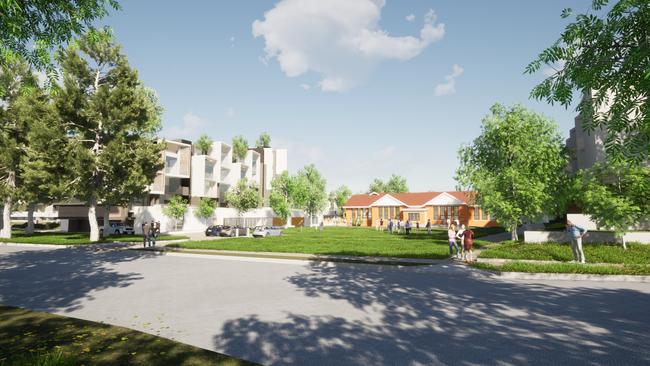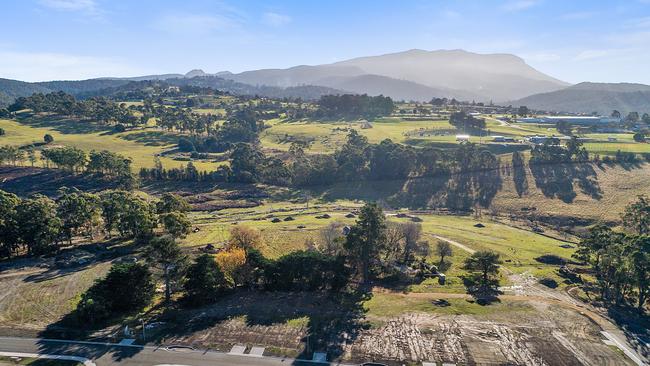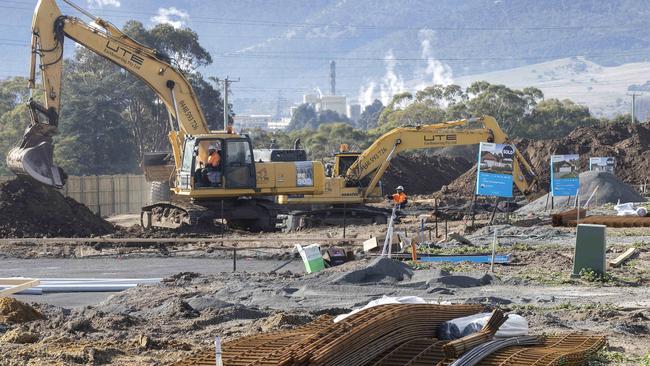BOOM TOWNS: Stunning images show evolution of Tassie suburbs
Stunning aerial photos have revealed the explosive growth of some of Tasmania’s most populated suburbs. See if your neighbourhood is on the list + upcoming developments >>
Tasmania
Don't miss out on the headlines from Tasmania. Followed categories will be added to My News.
Change is inevitable and the saying rings particularly true for a number of Tasmanian suburbs that have experienced explosive growth over the last 10 years.
Hobart city’s population has declined as inhabitants begin an exodus to outer suburbs and regional areas amid high house prices and a tough rental market.
Figures show greater Hobart’s population is shrinking by 330 people - a reduction of around 0.1 per cent over the past year - while the rest of the state increased by 1100 (0.4 per cent).
This shift has been recorded in stunning aerial images captured by Nearmap below that show developments, cul de sacs and new buildings popping up across our map over the past decade.
If you’re viewing this story on desktop, click and drag the slider tool from left to right to see how an area has changed since 2012. On mobile, click the picture left and right of the line to move the slider. See just how much your neighbourhood has changed ↓
Southern Tasmania
Over the past decade Bridgewater has seen the construction of multiple social housing complexes and residential and commercial buildings as the suburb records a boom in its population.
According to the Southern Tasmania Regional Land Use Strategy, the Brighton Council area is expected to see 15 per cent of the state’s growth to the year 2035 and will need about 2000 new homes to accommodate new residents.

The latest census data recorded for the area detailed that Bridgewater‘s population in 2016 was 4,045, however growth projections mean that the suburb could be home to nearly double that number in 2022.
Developments and subdivisions are slated for numerous areas in the neighbourhood over the coming years on Greenbanks and Cove Hill Roads.
The town of Campania in Tasmania’s Coal River Valley experienced a 7.1% annual population growth from 2011 to 2016 with the latest census data detailing that the region is home to around 900 people.
As seen in aerial comparisons the area is fast becoming a sought after location with many blocks of land popping up for sale including on Climie St and in the Coal River Valley Estate.
Home to approximately 8,000 Tasmanians, the evolution of Claremont’s growth has only just began with a major housing and mixed use development for the neighbourhood getting the tick of approval from the Glenorchy City Council.

The multimillion-dollar Windermere Bay Precinct is poised to take over the site of the former Claremont Primary School boasting 315 apartments and townhouses, local shops, a cafe, facilities including a gym and pool, and a childcare centre within a parkland setting.
The $200m development, designed by Circa Morris-Nunn Architects, will keep the original heritage-listed school building to be used for community facilities.
The suburb has recorded one of the largest growths for home values in Tasmania at a rise of 31.1% over the last year.
At just a swipe over the aerial comparisons, it’s extremely noticeable just how much development Clarendon Vale has seen over the last decade.
The population of the Eastern Shore community alongside other suburbs such as Rokeby, Oakdowns and Glebe Hill is predicted to swell to an excess of 10,000 within five years.
Clarence Mayor Doug Chipman said a big chunk of land between Clarendon Vale and Oakdowns had already been approved for subdivisions when speaking with the Mercury last year.
According to realestate.com.au, the average home in the 7019 postcode area has grown in value from $312,000 to $475,000 over the past two financial years.
This change of $163,000 - $81,500 annually outstrips the region’s average income of $48,248, according to Australian Taxation Office figures.
Sitting next to Clarendon Vale, the Eastern Shore suburb of Glebe Hill has also grown significantly over the last 10 years, and is set to boom even more.
A new $35m shopping centre is slated for the Eastern Shore suburb with construction underway on a Coles, McDonalds, sushi train, Subway and Liveat.
The construction is the first new major neighbourhood shopping centre to be built in greater Hobart in more than a decade.

The 5900m2 retail centre with 260 car spaces is set to create around 200 jobs during construction and over 350 ongoing jobs once it opens in September 2022.
Clarence Mayor Doug Chipman said he expected the development would help ensure more infrastructure and services were in place to meet the needs of an influx of people moving to the area.

“This development will provide a significant benefit for the growing area of Clarence Plains, which we predict will grow to a population of more than 20,000 people and become a satellite city in its own right in another ten years’ time,” he said.
The LGA of Kingborough, south of Hobart, is the fastest-growing municipality in Tasmania with council approving over 2,000 new dwellings in the last 10 years.
Kingston was one of 46 Hobart suburbs that recorded a double-digit annual median house price growth last year at a rise of 11.4 per cent.

According to the Australian Bureau of Statistics the suburb experienced a growth of 18.2% from 2006 to 2016 and the population of Kingborough now sits at around 37,000 people.
There looks to be no signs that the area’s growth will slow down anytime soon with lots of land up for sale in estates such as Whitewater Park and Springfarm.
Mornington is another suburb on the Eastern Shore that has experienced mass growth over the past 10 years.
In the span of four years the suburb’s population recorded a 2.7 per cent growth from 2011 to 2016 (last census data).
New developments have been popping up across the neighbourhood over the last year, attracting investors and young families looking to build.
According to realestate.com.au New Norfolk has seen a growth rate of 26.8 per cent for houses and 38.3 per cent for units as young families flock to the suburb north west of Hobart to get their foot into the door of the property market.
The historical area is continuing to flourish with council approving a large-scale $500m revitalisation development called the Mills Project.

The project will include a 198-home retirement village, 700 residential lots, a 100-bed private hospital, a 100-bed boutique hotel and a childcare centre.
The development is expected to create 1,100 jobs between 2021 and 2040.
Oakdowns on Hobart’s Eastern Shore lays in one of Greater Hobart’s largest growth corridors.
The massive transformation of the area reflects a mix of community housing and affordable living options.
Oakdowns falls under the Clarence Plains area — made up of the suburbs of Rokeby, Clarendon Vale, Oakdowns and Glebe Hill - which is tipped to swell to in excess of 10,000 within five years.
In late 2021 Clarence City council launched a master plan for the booming area, aimed at ensuring Clarence Plains can cope with the growth.
Expanding housing stock, community development, public open spaces, connectivity and infrastructure are some of the key objectives of the plan.
Sorell, 30 minutes east of Hobart, has experienced a ‘landbuying frenzy’ over recent years with new subdivisions changing the face of what is fast becoming a satellite city.
Sorell is also tipped to be a major beneficiary of the Tasmanian Government’s Sorell to Hobart corridor plan which when complete, promises to lower commute times between the city and the suburban locality, while fostering greater tourist usage.
Northern Tasmania
Rising property markets in Launceston have seen areas including Summerhill, Prospect and South Launceston boom in recent years.
Fresh off its designation as a UNESCO City of Gastronomy and crowning as wotif.com’s Aussie Town of the Year, Launceston is puffing its chest out as one of Australia’s most cosmopolitan regional cities.
The northern capital now boasts a pipeline of projects that will make a city’s footprint three times its size.
The result was the Greater Launceston Plan, produced in conjunction with West Tamar, Meander Valley, George Town and Northern Midlands councils, a “major strategic project to develop a unified and holistic approach to co-ordinate the long term planning and management of the city and broader greater urban area”.
North West
Burnie is renowned for some of the states lowest property prices with all the creature comforts of city living.
Adding to this, in April 2022, the state government announced plans to make available more than 100 dirt-cheap blocks of land for low and middle incoming earners, with some costing just $75,000 and others only 4km away from a northern Tasmanian CBD.
The idyllic beachside town of Penguin has made a transformation of sorts over the past 20 years from its traditional port trading routes to a sought-after Tassie tourism stop.
Penguin on Tasmania’s North-West Coast recently came in at number four on the Australian Traveller’s list of best coastal haunts, which looked at our most spectacular shores.
Over the last 12 months, Turners Beach median house prices have jumped 24.7 per cent over the 12 months to $542 500. Our satellite imaging shows significant growth while latest property data shows only one rental available with 9 available on the market - suggesting those who snag a place at the seaside locality tend to stay.
Ulverstone has become somewhat of a staple on the Price Predictor Index’ Consistency Top 50.
Hotspotting’s Terry Ryder said “consistency suburbs” in the report represented “safety for investors”.
“Markets with this level of even performance often have good price growth over time,” he said.
20 year satellite imaging (above) also shows significant growth.
The aerial imagery is from Australian location intelligence company Nearmap. The company provides government organisations, architectural, construction and engineering firms, and other companies, with easy, instant access to high resolution aerial imagery, city-scale 3D content, artificial intelligence data sets, and geospatial tools to assist with urban planning, monitoring and development projects in Australia, New Zealand, and North America.




